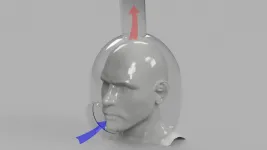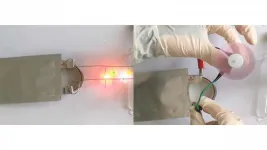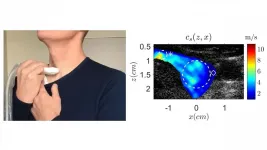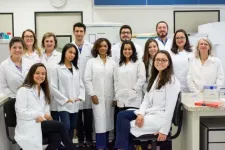(Press-News.org) Stiffness in our tissues causes tension in our cells. Research from the Buck Institute, the University Health Network (University of Toronto), Stanford University, and the University of Alberta shows that stiffness impacts the innate immune system by upping its metabolism. The findings suggest the cellular tension likely sets off an inflammatory loop that contributes to the development of chronic diseases of aging. Publishing in Cell Reports, Buck Associate Professor Dan Winer, MD, and colleagues present an emerging way of looking at how the immune system functions, possibilities for new immunotherapeutics, and a call for scientists to reconsider the way they do research.
While stiffness is a recognized factor in acute infections (think swollen lymph glands or swelling after a cut), Winer is particularly focused on how stiffness that arises from the environment impacts immune cells. "While viruses and bacteria are key players in triggering an immune response, we think that the forces in the environment around the cells are an extremely important part of the puzzle that influences immunity," he said. "Stiffness in our tissues and the resulting cellular tension changes in most diseases, as well as in aging itself," said Winer. "This work provides support for a new way of thinking about how the immune system functions, suggesting that mechanical force primes and likely controls immunology during acute and chronic disease because it readies the immune system in the face of danger."
Winer and his team, led by Mainak Chakraborty, MSc, Research Assistant at the University Health Network in Toronto and Sue Tsai, a former post-doctoral fellow in the lab, now an Assistant Professor at the University of Alberta, cultured dendritic cells (DCs), a component of the innate immune system that orchestrates an immune response, from mouse bone marrow and spleen at different degrees of physiological stiffness. "DCs grown at physiological resting stiffness showed reduced proliferation, activation and cytokine production compared to cells grown under high stiffness which mimicked fibro-inflammatory disease," said Chakraborty. "High stiffness grown DCs showed increased activation and flux in major glucose metabolic pathways," added Tsai. "In models of autoimmune diabetes and tumor immunotherapy, the cellular tension primed the DCs to elicit a response from the adaptive immune system, which kicks in specifically and secondarily following infection or injury." The findings were not limited to mouse DCs, as human DCs also showed enhanced markers of activity under higher tension.
Researchers identified the Hippo-signaling molecule, TAZ, as an important factor impacting DC metabolism and function under tension in the innate immune response. Winer says that finding is significant, given that a lab at the University of California, Los Angeles recently showed that same pathway facilitated the effects of tension in the adaptive immune system. "This seems to be a critical pathway for sensing environmental force in both arms of the immune system," said Winer. "Mechanoimmunology still has been understudied. We hope our work moves this emerging field forward and leads to the development of new force-targeting immunotherapies that would allow the immune system to function normally across the many conditions that alter tissue stiffness."
Big implications for killer diseases and chronic diseases of aging
Winer says there are number of diseases predicted to be influenced by the impact of tissue stiffness on the immune system. "Heart disease, cancer and lower lung disease are among the top causes of death in the U.S.," he said. "Computer algorithms from our study show that all of these conditions are strongly modulated by genes or protein interactions that are induced by tension in the immune system. Those studying these diseases should consider this finding."
Noting that tissue stiffness is a well-known phenomenon associated with aging (for instance, the lungs and their blood vessels can double in stiffness with age), Winer says it's likely that the interaction with the immune system contributes to the low-grade chronic inflammation that fuels many of the diseases of aging. "The tension from the stiffness promotes metabolism and cytokine production in DCs which may potentially contribute to what is now known as inflammaging." Winer says his lab plans on looking at mechanoimmunology in aging mice and in the context of specific diseases.
Winer says the genes that are activated via cellular tension are potential targets for immunotherapeutics, which is another focus in his lab. He says techniques now exist (via an add-on to Magnetic Resonance Imaging or ultrasound) that enable the mapping of tension in specific tissues and organs. Winer says the ability to track the tension could provide a biomarker of aging and make it easier to test new drugs.
A final note to researchers: Be wary of culturing on plastic!
Almost as important as the findings in this study, Winer is urging researchers to consider changing the way they culture immune cells. He says for decades the vast majority of scientists have been using plastic plates to grow their cells, which exerts tension thousands of times higher than what a cell feels in the body. "Many immune cells need to anchor themselves in the dish and the stiffness of the plastic imparts supraphysiological force on the cells" he said. Winer's team grows immune cells on soft silicone gels which have been treated to closely mimic the physiology inside the body. "We think adopting new research culturing techniques in immunology might better mimic the physiology inside the body."
INFORMATION:
Citation: Mechanical Stiffness Controls Dendritic Cell Metabolism and Function
DOI: 10.1016/j.celrep.2020.108609
Other collaborators include: Saad Khan, and Helena Lei, Diabetes Research Group, Toronto General Hospital Research Institute, Toronto, Canada; Kevin Chu, Megan Lee, Camille Huang, Masoud Akbari, Xavier Clemente-Casares, and Sue Tsai, Department of Medical Microbiology and Immunology, University of Alberta, Alberta, Canada; Annie Shrestha, Faculty of Dentistry, University of Toronto, Canada; Shawn Winer, Department of Laboratory Medicine and Pathobiology, University of Toronto, Canada; Xavier S. Revelo, Center for Immunology, University of Minnesota, Minneapolis, MN; Fanta Barrow, Department of Integrative Biology and Physiology, University of Minnesota, Minneapolis; Xiangyue Zhang, and Edgar G. Engleman, School of Medicine, Department of Pathology, Stanford University, Palo Alto, CA; Matthew Gold, and Pamela S. Ohashi, Princess Margaret Cancer Centre, University Health Network, Toronto, Canada; Yi Tao Chan, Department of Immunology, University of Toronto, Canada; Nicholas K. Kotoulas and Cynthia Goh, Department of Chemistry, University of Toronto, Canada; Juan Jovel, Faculty of Medicine and Dentistry, University of Alberta, Canada; Chiara Pastrello, Max Kotlyar, and Igor Jurisica, Osteoarthritis Research Program, Schroeder Arthritis Institute, Toronto, Ontario, Canada; and Evangelos Michelakis, Department of Medicine, University of Alberta, Canada.
This work was supported by grants from the Queen Elizabeth II Graduate Scholarship in Science and Technology (QEII-GSST)/Aventis Pasteur, the Banting & Best Diabetes Centre (BBDC)-Novo Nordisk Studentship, the National Research Council H.L. Holmes Postdoctoral Fellowship, the Li Ka Shing Institute of Virology Bridge Fund, the New Frontiers in Research-Exploration Fund, Canadian Institutes of Health Research, and the Huiying Memorial Foundation, Ontario Ministry of Innovation Early Researcher Award, Ontario Research Fund, Natural Sciences Research Council, Canada Foundation for Innovation, Buchan Foundation and IBM.
About the Buck Institute for Research on Aging
At the Buck, we aim to end the threat of age-related diseases for this and future generations. We bring together the most capable and passionate scientists from a broad range of disciplines to study mechanisms of aging and to identify therapeutics that slow down aging. Our goal is to increase human health span, or the healthy years of life. Located just north of San Francisco, we are globally recognized as the pioneer and leader in efforts to target aging, the number one risk factor for serious diseases including Alzheimer's, Parkinson's, cancer, macular degeneration, heart disease, and diabetes. The Buck wants to help people live better longer. Our success will ultimately change healthcare. Learn more at: https://buckinstitute.org
WASHINGTON, January 12, 2021 -- The risk of infection of COVID-19 is high for medical specialists who come in contact with symptomatic or asymptomatic patients. Dentists and otolaryngologists are at particular risk, since they need direct access to the mouth, nose, and throat of patients.
The current solutions, which include wearing N95 masks and face shields, clinic room evacuation, negative pressure rooms, and special air filtration systems, are expensive, not highly effective, and not very accessible.
In Physics of Fluids, by AIP Publishing, researchers at Cornell University discuss their design of an open-faced helmet for patient use ...
WASHINGTON, January 12, 2021 -- Sodium-ion batteries are a potential replacement for lithium batteries, but the anodes -- positively charged electrodes -- that work well for lithium-ion batteries don't provide the same level of performance for sodium-ion batteries.
Amorphous carbon, which lacks a crystalline structure, is known to be a useful anode, because it has defects and voids that can be used to store sodium ions. Nitrogen/phosphorus-doped carbon also offers appealing electrical properties.
In Applied Physics Reviews, from AIP Publishing, researchers in China from Zhejiang University, Ningbo University, and Dongguan University of Technology ...
What The Study Did: Variations and changes in national and state rates of neonatal abstinence syndrome and maternal opioid-related diagnoses were examined in this observational study.
Authors: Ashley H. Hirai, Ph.D., of the Health Resources and Services Administration in Rockville, Maryland, is the corresponding author.
To access the embargoed study: Visit our For The Media website at this link https://media.jamanetwork.com/
(doi:10.1001/jama.2020.24991)
Editor's Note: The article includes conflicts of interest and funding/support disclosures. Please see the article for additional information, including other authors, author contributions and affiliations, conflict of interest and financial disclosures, and funding and support.
INFORMATION:
Media advisory: ...
WASHINGTON, January 12, 2021 -- Singing may be the next-generation, noninvasive approach to determining the health of a patient's thyroid.
Typically, a fine needle is used to detect the presence of a tumor in the thyroid, which most commonly affects children and younger women. However, this method can only detect about 5% of thyroid cancers.
Researchers from Université de Tours, Centre Hospitalier Universitaire de Dijon-Bourgogne, and Université Bourgogne Franche-Comté suggest a simpler approach: singing. They demonstrate the technique in the journal Applied Physics Letters, from AIP Publishing.
"Developing noninvasive methods would reduce the stress of patients during their medical exams," said Steve Beuve, one of the authors. "Having to sing during a medical ...
What The Study Did: National register data from Denmark were used to examine if people with autism spectrum disorder (ASD) have higher rates of suicide attempts and suicide compared to those without ASD and to identify potential risk factors.
Author: Kairi Kõlves, Ph.D., of Griffith University in Brisbane, Australia, is the corresponding author.
To access the embargoed study: Visit our For The Media website at this link https://media.jamanetwork.com/
(doi:10.1001/jamanetworkopen.2020.33565)
Editor's Note: The article includes funding/support disclosures. Please see the article for additional information, including other authors, author contributions and affiliations, conflict ...
BOSTON -- For women hoping to achieve a pregnancy using freshly retrieved donor eggs, a new retrospective study led by researchers from Brigham and Women's Hospital may provide important insight. Brigham senior author Janis H. Fox, MD, had observed that when freshly retrieved donor eggs were used, pregnancy rates were higher for fresh compared to frozen embryo transfers. Fox and her colleagues were intrigued by this observation. The team set out to scientifically determine if this observation would be replicated in a larger sample of recipients. Leveraging national data from the Society for Assisted Reproductive Technology (SART), the Brigham researchers found that, in cycles using freshly retrieved donor eggs, fresh embryo transfers were indeed ...
A detailed analysis of the burden of osteoporosis in eight Eurasian countries has found that osteoporosis is a significant and growing health problem in the region that will escalate in the future due to expected demographic changes.
The authors of the Audit report [1] carried out a review of the available literature and a survey of the representatives of the national osteoporosis societies in eight Eurasian countries. The Audit reviews both the burden and the differences between Armenia, Belarus, Georgia, Moldova, Kazakhstan, the Kyrgyz Republic, the Russian Federation, and Uzbekistan with regard to the prevalence of osteoporosis and incidence of osteoporotic fractures, future demographic changes, diagnostic resources, and treatment availability.
The findings ...
WASHINGTON -- Researchers have developed a new laser-based process for 3D printing intricate parts made of glass. With further development, the new method could be useful for making complex optics for vision, imaging, illumination or laser-based applications.
"Most 3D printing processes build up an object layer by layer," said research team leader Laurent Gallais from The Fresnel Institute and Ecole Centrale Marseille in France. "Our new process avoids the limitations of these processes by using a laser beam to transform -- or polymerize -- a liquid precursor into solid glass."
In The Optical Society (OSA) journal Optics Letters, Gallais and research team members Thomas Doualle and Jean-Claude Andre demonstrate how they used the new technique to create detailed objects in ...
The abundant presence of an enzyme known as low molecular weight protein tyrosine phosphatase (LMWPTP) in tumor cells has long been considered an indicator of cancer aggressiveness and metastatic potential. It is also known to perform important functions in cells under normal conditions, participating in both the proliferation process and the regulation of intracellular systems. Research continues on its role in cancer progression.
In Brazil, a group of researchers at the University of Campinas’s In Vitro Bioassay and Signal Transduction Laboratory led by Professor Carmen Veríssima Ferreira-Halder are studying the possibility of inhibiting this protein phosphatase ...
Scientists have determined the optimal conditions following a stem cell transplant that could control HIV without the need of an everyday pill, according to a study published today in eLife.
Finding the right balance of stem cell dose, cell type and timing of antiretroviral therapy (ART) could potentially lead to a spontaneous cure of HIV.
There are only two cases of HIV cure to date: the Berlin Patient and the London Patient, who both received stem cell transplants with stem cells from donors that lack a molecule called CCR5, which HIV is attracted to.
"The major obstacle to HIV eradication is a latent reservoir of long-lived infected cells, and cure strategies aim to eliminate all infected cells or permanently prevent viral reactivation ...



